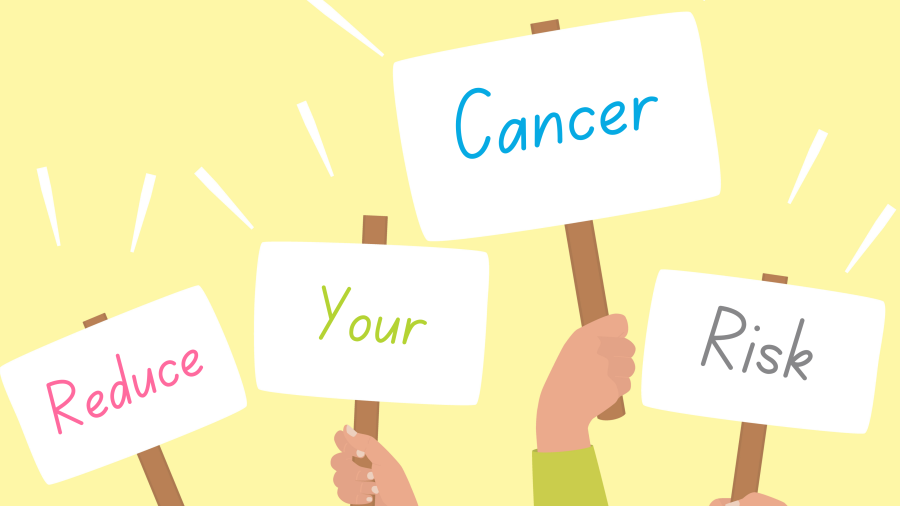
How we can reduce our cancer risk
through simple lifestyle changes
Cancer seems a terrifyingly random disease – an ominous, senseless illness that seems to strike without rhyme nor reason. But while there is a truly random element to cancer, there is an enduring misconception we are powerless to insulate against it. This is however a misconception – the reality is that many cancers are linked to our lifestyle, which means we have more control than we might think over most of the most serious cancers. While we cannot foresee the future, we can take proactive steps to give ourselves the best odds against it. To this end, Breakthrough Cancer Research and our Irish Cancer Prevention Network (ICPN) partners have developed a useful guide of 12 practical measures we can all take to reduce our risks.
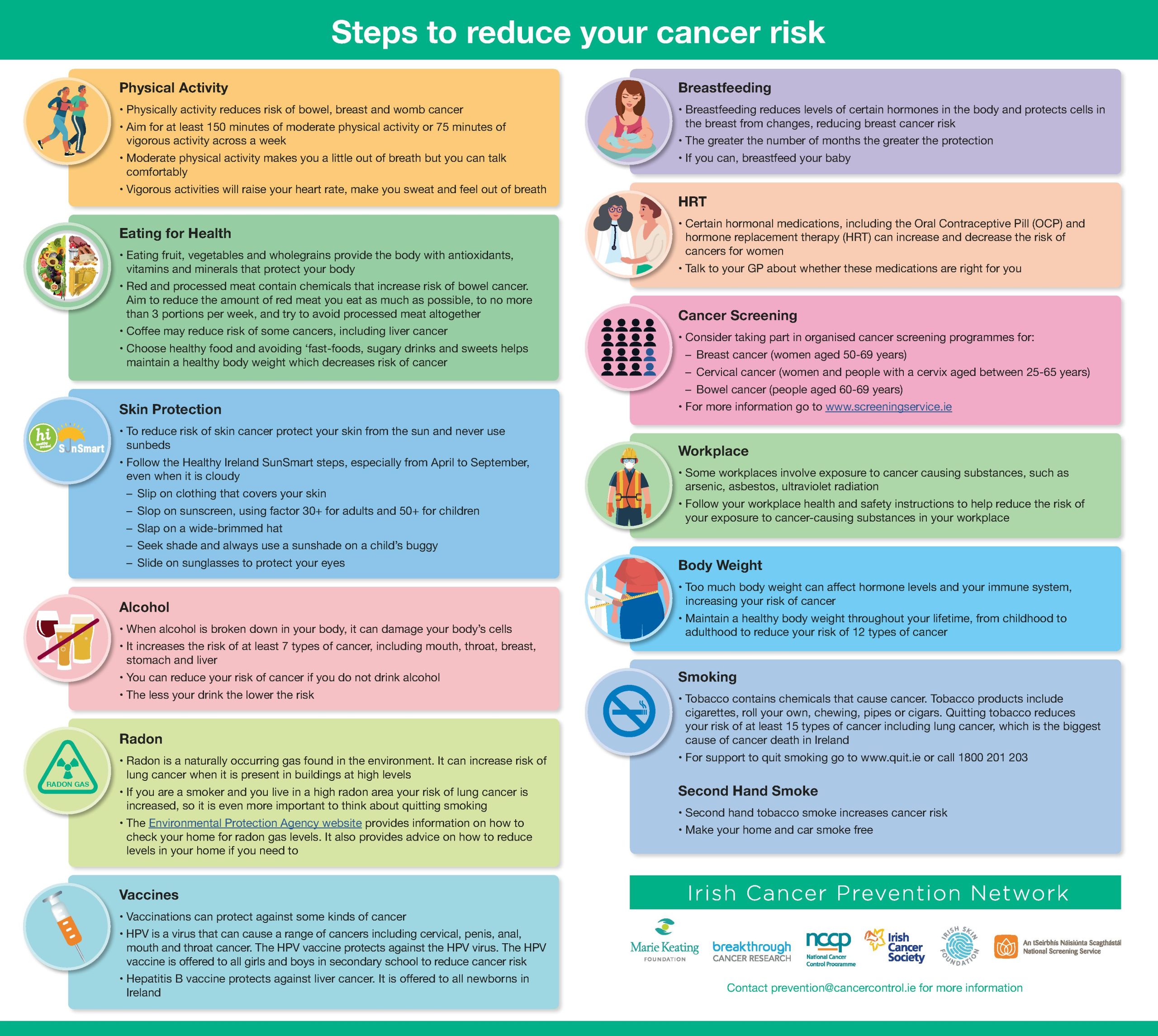
In this companion piece, we delve into the science behind these recommendations, to understand what underpins them, and to better understand the science of cancer prevention.
Exposure to carcinogenic agents
Cancer is not a single monolithic disease, but rather an entire family of maladies characterised chiefly by abnormal cell division. There are many ways that a cancer can arise, but perhaps the most common is damage to DNA. Everyday, we are exposed to numerous agents which can damage our DNA. As we have evolved clever mechanisms to adapt to this damage, the vast majority of this harm is temporary and easily repaired. But sometimes, these mechanisms fail, and damage eventually accumulates. When this damage persists, mutations can emerge that ultimately result in a cancer.
Agents that can cause this damage are known as carcinogens, and we are exposed to many of them in the course of everyday life. Perhaps most common is sunlight itself – ultraviolet light can cause the requisite DNA damage that leads to a variety of different skin cancers. However, risk from sunlight can be mediated by limiting exposure, and by using sunscreen. This is especially relevant on sunny days, but it is important to note that ultraviolet radiation is invisible, and can still cause damage even on overcast days. The UV-Index, given with the weather forecast, is a measure of the intensity of ultraviolet radiation from sunlight. Sun protection is suggested for a UV Index of over 3, which can prevent the beginning of skin cancers.
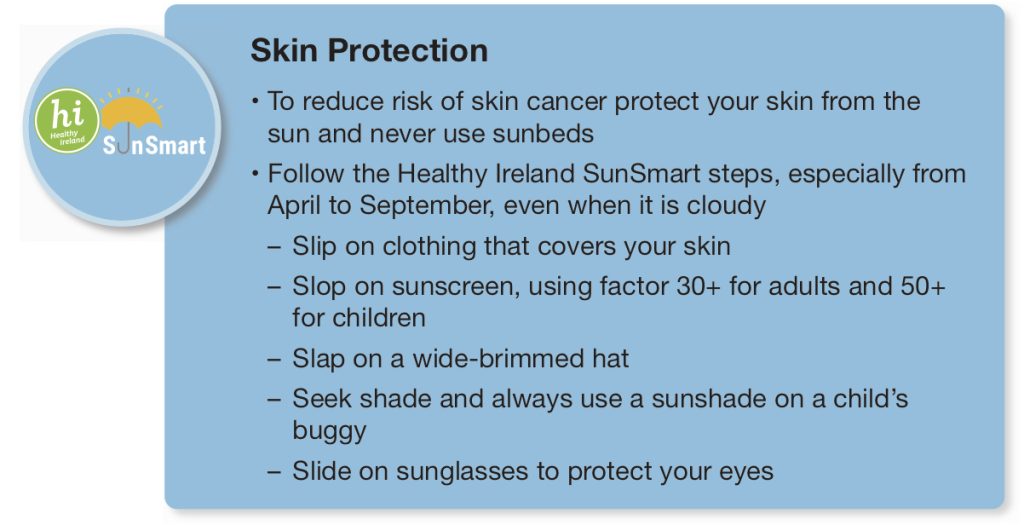
Alcohol too is another common carcinogen, associated particularly with head and neck cancers. The breakdown of ethanol leads to a toxic by-product known as acetaldehyde, which can damage DNA and lead to cancer formation. Excessive alcohol consumption also can lead obesity, which itself comes with increased cancer risk, discussed in the subsequent section. Accordingly, reducing consumption of alcohol also reduces cancer risk. Workplace chemicals and fumes can come with an increased risk of cancer too. Exposure to particulate asbestos, for example, is strongly correlated with mesothelioma. To reduce risk of cancer incidence, proper ventilation and storage of workplace chemicals is of paramount importance, and care should be taken handling these agents.
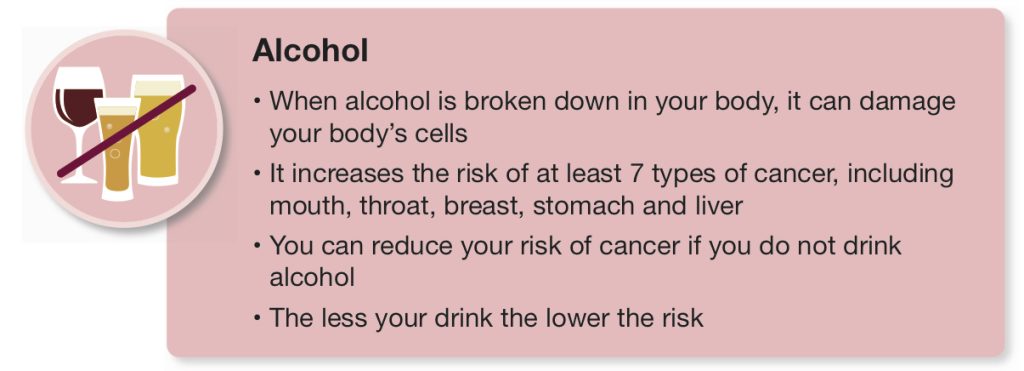
Some agents of harm are obvious and well-known. Smoking is chief among this rogue’s gallery – many of the chemicals in cigarette smoke are carcinogenic, and their long-term inhalation can eventually lead to lung cancer. For smokers, cessation is perhaps the single most impactful change they can make in reducing their cancer risk; those who quit smoking reduce their lung cancer risk by 30% – 50% after 10 years relative to those who continue smoking, and they half their risk of mouth or oesophageal cancer in half within 5 years of quitting. There are also less obvious agents of harm. Radon is a naturally occurring radioactive gas that stems from the breakdown of uranium and thorium in soil and rocks. As it is odourless and inert, it can be trapped when it penetrates into buildings and inhaled. In high volumes, it can eventually cause lung cancer. Newer builds are typically designed to minimise radon retention, and mitigation measures such as improved ventilation and radon alarms can be significant life-savers over time.
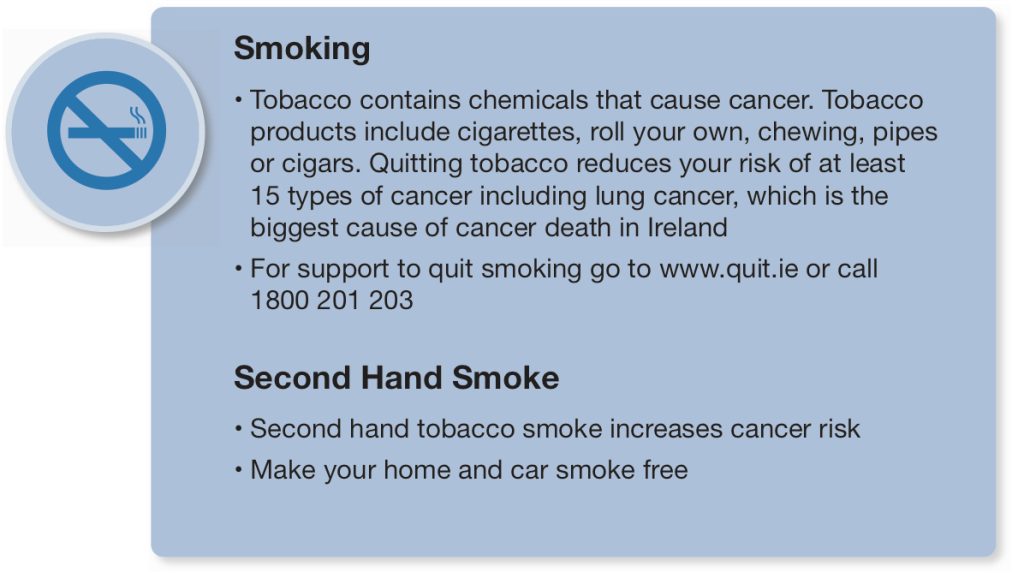
Other nefarious elements are more sinister. Human papilloma virus (HPV) is a family of viruses that live on human skin. Some strains live on genital skin, and are easily spread by sexual contact, infecting over 80% of sexually active adults at some stage throughout their lifetime. For the vast majority of people, this infection is cleared by the immune system. For an unfortunate few, however, the infection persists. Cervical cancer, affecting over 230,000 women each year, is the most well-known consequence. Anal, head and neck, and penile cancer too are frequently caused by HPV infection. In total, about 5% of all cancers are HPV mediated. But grim as this statistic is, the incredible news is that a vaccine finally exists capable of banishing the presence of these awful cancers to history. The HPV vaccine is staggeringly effective, and most efficacious when given before the commencement of sexual activity. It is now available for both girls and boys early in the secondary school cycle, hugely reducing the risks for future generations. For those of us too old to avail, screening is a related life-saving intervention, covered later in this article.
Diet, exercise, and obesity
The relationship between obesity and cancer is frequently overlooked in public discussions about cancer, but it is a vital facet of prevention. The data to date strongly indicates that greater body weight is strongly linked to increased incidence of a whole family of cancers. Pancreatic cancer, for example is 50% more likely to occur in obese people than those of a healthier weight, while liver cancer is twice as prevalent in obese patients. For women, results are even more stark – endometrial, ovarian, and breast cancers are all associated with higher body mass. In the United States, an estimated 40% of all cancers are strongly associated with being overweight and obese.
The precise details of how obesity elevates cancer risk are complex and much remains to be understood, but there are a number of mechanisms scientists know contribute to excess risk. The first of these is inflammation; visceral fat cells tend to be relatively large, and abundant. In an environment of excessive fat, the resultant low oxygen conditions trigger inflammation and immune system responses. When this persists long term, the net result can ultimately be DNA damage, leading to the emergence of cancer. The picture is complicated by the fact that other obesity related mechanisms can occur in tandem. For instance, obesity triggers overproduction of hormones such as insulin and oestrogen. This in turn leads to production of excess cells, and with it, elevated tumour risk.

All these factors together mean that one’s personal cancer risk increases in proportion to their obesity level. This is a risk factor we can influence, and we can diminish our personal cancer risk by reducing our visceral body fat and keeping our body weight within recommended ranges. Physical activity and Eating for Health in the form of a balanced diet are a vital part of achieving this, and together they can substantially lower our cancer burden. Certain foods too can influence cancer risk. Processed meats are carcinogenic, and diets high in these foodstuffs come with a higher cancer risk. It is however important to see this risk in context – a person who consumes 50g of processed meat a day has a 1% higher risk of colorectal cancer over a lifetime relative to someone who eats none. Even though this risk is small, it is not negligible, and decreasing consumption of these foods reduces lifetime risk.
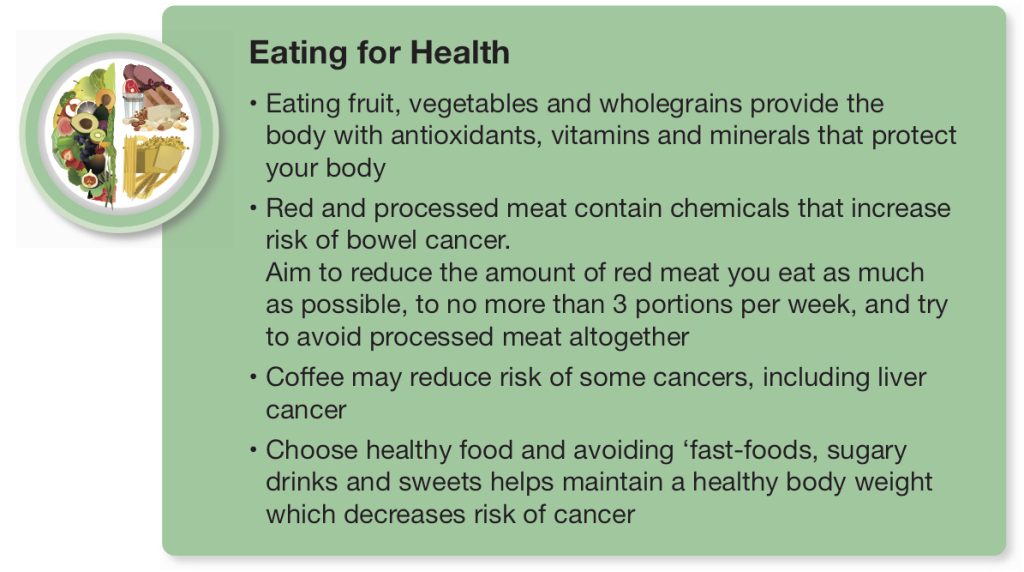
While diet and exercise are critical to maintaining our physical health and keeping our risk of cancer low, it is also crucial to note that there are an abundance of misunderstandings and misinformation about food and cancer. Despite a litany of misleading claims online, there are no foods can cure cancer, nor do foodstuffs like sugar ‘feed’ tumours. Restrictive diets in general, including the Ketogenic diet and Alkaline diet, are not beneficial for patients, pivoting on a mangled misunderstanding of cancer biology. Not only are these diets useless, they can be actively damaging to patients, and advice should always be sought from an oncology dietician when embarking on new nutritional approaches. (Check out our own Nutrition section for evidence-based advice and resources for people with cancer).
Hormones and cancer
Aside from the elevated cancer risk from obesity-related insulin and oestrogen production, there are other hormonal factors which can influence cancer risk. Long term observational studies suggest that Hormonal contraceptives can result in a modest increase in one’s risk of breast cancer in some instances, although the data is conflicted. In other cancers like endometrial, colorectal, and ovarian cancer, pill-usage can seem to be associated with a modest decrease in risk. Whether these differences in apparent risks are testament to a real biological difference or an artefact of observational study design isn’t yet clear and may attest to individual differences. It is worthwhile then to discuss different medications with a GP. Again, maintaining a healthy body weight is something that people can do to reduce any negative ramifications of unnecessary hormone production.
While the precise mechanism remains unclear, breastfeeding too seems to reduce the cumulative risk of both breast and ovarian cancer. One theory is that breastfeeding delays the menstrual cycle, reducing lifetime exposure to oestrogen. While more research is required to clarify precisely why this is the case, the relative risk reduction seems to be around 4.3% for every 12 months a woman breastfeeds relative to those who do not.
Cancer screening
Partaking in cancer screening is a powerful method for reducing one’s cancer risk. Cervical cancer screening, which aims to detect changes caused by persistent HPV infection before they become cancers, has brilliant efficacy. For screened populations, this results in about 83 cases of cervical cancer per 100,000 women, relative to 1886 cases in 100,000 unscreened populations, a relative risk reduction of almost 96%. Similarly, those who undergo colorectal cancer screening have a 34% reduction in the lifetime incidence of colorectal cancer. Breast cancer screening too is a well-known life saving intervention. Attending one’s recommended screening appointments is a proactive measure that tangibly reduces cancer risk.
For these reasons, the 12 measures outlined can markedly reduce cancer risk. It is important to bear in mind, of course, that there is still a highly random element to cancer. Even the healthiest and most cautious of lifestyles is not a guarantee one will never get cancer, nor is anyone ever responsible for their cancer. Cancer is a disease, not a moral judgement. But the steps here are pragmatic and practical ways to give yourself the best chance of reducing your risk. Better still, all have the invaluable bonus of improving our general health too. Together, these measures give us the best possible hand for an uncertain future.
Author: Dr. David Robert Grimes, Cancer Researcher and Physicist.
Downloadable Recipe Cards
Chicken Stir-Fry with Cashew Nuts
Grilled Lemon Scented Salmon with Chickpea, Tomato & Spinach Ragout
You can also purchase the ‘The Anti-Cancer Cookbook’









 Contact
Contact